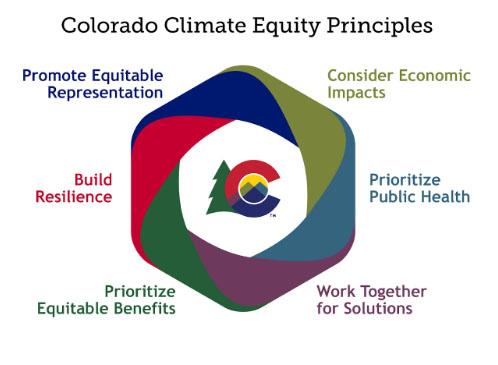Climate Change Goals & Actions: Equitable Transition
CC Goals - Equitable Transition
What is a just energy transition and equitable climate future?
The transition from fossil fuels to clean energy resources must improve the lives of disproportionately impacted communities, while also supporting workers and communities that have depended economically on fossil fuel industries. Equity and justice in energy and climate transition also must elevate underrepresented voices, protect people’s health, save money, and create economic opportunities.
Explore Colorado's Three Climate Pillars: Mitigation - Adaptation - Equitable Transition
Colorado established the nation's first Office of Just Transition to support communities traditionally reliant on coal for employment and property tax generation, and created the first Colorado Climate Corps program to provide resources and education to underserved communities.
Equitable Energy and Climate Future Goals
Climate change affects some Coloradans more than others. Communities of color and low-income residents experience greater harm from extreme heat, rising energy bills, and wildfire smoke. These residents may also live in more polluted areas with older, less energy-efficient housing, making climate impacts more dangerous. They may lack access to adequate healthcare, not have money to repair damage from natural disasters, or cope with rising energy and food costs.
The State’s goal is to address climate change in a way that creates positive health and economic impacts and better access to clean energy technologies for disproportionately impacted communities.
To meet this goal, the State is committed to engaging people of color, low income residents, tribal nations, and rural communities from across the state in the clean energy transition.
The State’s six climate equity principles are to: promote equitable representation; consider economic impacts; prioritize public health; work together for solutions; prioritize equitable benefits; and build resilience.
Environmental Justice Program
The Environmental Justice Program was created in 2021 to advance environmental justice across all of the Colorado Department of Public Health and Environment’s environmental divisions, including the Air Pollution Control Division, which regulates climate-harming greenhouse gas pollution. The program supports the environmental justice initiatives led by the divisions by offering tools, training, and other resources.
Environmental Justice Action Task Force
The Environmental Justice Action Task Force was a 22-member governor-appointed group. The Task Force was directed by the Environmental Justice Act “to recommend and promote strategies for incorporating environmental justice and equity into how state agencies discharge their responsibilities.” The Task Force published a set of recommendations for state government in 2022 after gathering community feedback from across the state for nearly a year. On March 1, 2023, Governor Polis sent CDPHE a letter with instructions to implement the recommendations of the Task Force.
Colorado EnviroScreen
Colorado EnviroScreen is an interactive environmental justice mapping tool that enables users to identify disproportionately impacted communities based on the definition in Colorado’s Environmental Justice Act. The tool, managed by the Environmental Justice Program at the Colorado Department of Public Health and Environment, is used by state agencies and other organizations to evaluate potential environmental justice impacts and prioritize funding, technical resources, and outreach efforts.
Office of Just Transition
Colorado created the Office of Just Transition in 2019 to assist workers and communities that will be adversely affected by the loss of jobs and revenues due to the closure of coal mines and coal-fired power plants. Its purpose is to help workers transition to new high-quality jobs, to help communities continue to thrive by expanding and attracting diverse businesses, and to replace lost revenues. It also engages in environmental justice efforts with communities that have faced and continue to face environmental health disparities due to pollution-producing facilities.




